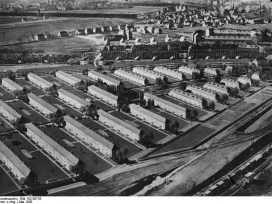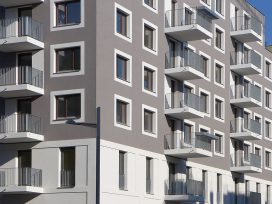Debates about housing have taken centre stage once again. While the question of housing shaped cities as well as the lives and concerns of urban dwellers throughout the nineteenth and twentieth centuries, it gradually became less and less important. But now it is back and recent developments are influencing these debates.
The housing question and the critique of functionalism
Only years after contemporary architecture had moved beyond modernist housing estates, which were once branded as housing bunkers or derided as ‘new towns’, housing has assumed its place once again in the canons of architecture, planning and public policy. From exhibitions, festivals and conferences to articles and books, people are now thinking about how to provide housing in cities for the ‘masses’ (a word that seemed to have been banished from architectural discourse for some time). Lengthy criticism of the monotony and boredom of the modernist housing estate, of modernist urban planning’s separation of functions and of its structural deficiency have all left their mark on architecture. A look at planners’ renderings and collages shows that the mixing of functions, the simultaneity of different programmes and the romantic image of the historic city centre are still very much a part of idealised visions of the city of tomorrow.
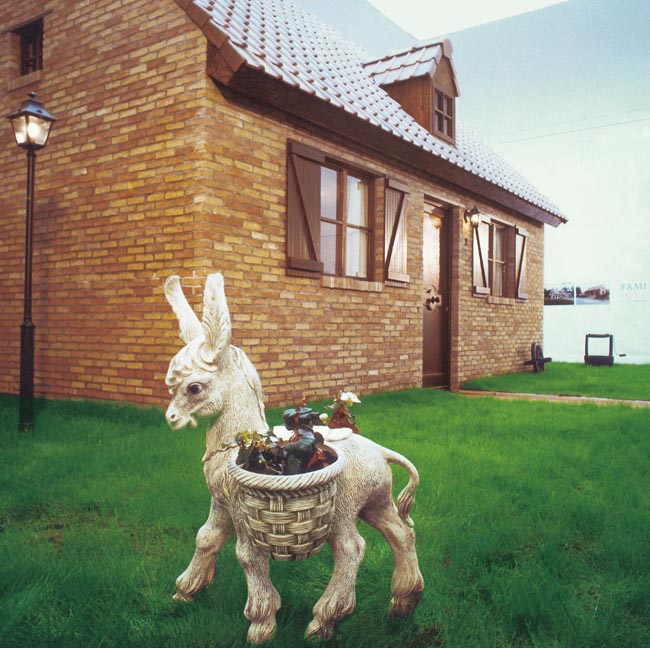
‘Fami-Home’ installation by the Belgian artist Guillaume Bijl. Photographer: Marranzano. Photo via Guillaume Bijl’s personal archives from Wikimedia Commons
But it seems that reality is catching up with architecture. Historic city centres no longer contain cheap (if insalubrious) niches in which anything seems possible, as they did in the early days of the critique of functionalism. City centres are now sites of skyrocketing rents in which gentrification raises the question of who will be the next to move out. And the notion of ‘mixed functionalities’ often boils down to nothing more than adding shopping arcades alongside a housing stock, or sprinkling a few short-term rental properties, which can be made even more profitable by marketing them via online platforms rather than renting them under standard terms.
All of this is to say that housing is of central concern once again. The majority of European conurbations, especially the centres of large cities, are now faced with rapidly rising housing prices. Even in Vienna, an example of a city experiencing strong growth and whose housing supply remains exceptionally good by European standards, private-sector rents have increased by 34% between 2008 and 2014. This is more than two and a half times the average price increase over the same period.
Despite more subsidized, rent-controlled housing having been built in Vienna than in other cities, there remains a shortage of living space, or, more precisely, a shortage of accessible and affordable housing for all, which has prompted a discussion about possible strategies for providing affordable dwellings in a short period of time. Even the expression ‘building as much as possible as quickly as possible at the lowest possible cost’ is indebted to functionalism, for it was precisely this concern that marked the starting point of both the functionalist urban planning of New Objectivity and post-1945 functionalism, whose technocratic, construction-oriented approach played a decisive role in shaping European cities.
The return of past debates
But it is not just the housing question itself or the matter of securing housing at affordable rents that recall earlier historical debates. There are parallels to be made between the current debate and the way the housing question has been negotiated historically. These parallels concern both the junction of the housing question, with its imputed social role, and (at least in general terms) the strategies and instruments designed to remedy it, such as housing construction and land policy and the ensuing patterns from these arguments, which have shaped the fundamentals of housing in society.
The housing question cannot be restricted to the construction and provision of new housing. In both concept and reality, housing encompasses a multitude of practices, techniques, and forms of knowledge vectors by means of which the social question (rampant inequality, the impoverishment of the proletariat, unemployment and pauperization in the wake of industrialization and skyrocketing urban growth, which all leave a mark in the form of substandard housing) were brought into the heart of public discourse.
These practices, techniques and forms of knowledge, such as statistical recording, hygienic measures, moral judgments, regulatory decisions, administration, architecture and planning that altogether form what we understand as housing are all a heterogeneous ensemble that can perhaps be best understood through Foucault’s notion of the dispositif. Housing policy should not be seen as the regulation or governing of residential living from top-down by a state apparatus, but rather in terms of interaction between residents and other interested parties, institutions and the built and lived-in world itself.
Housing is not rigidly structured, but in constant flux. Housing policy did not begin with the construction programmes of the 1920s and 1930s, which were initiated in several European cities by social democratic or liberal administrations to combat the shortage of housing stock.
It actually predates this period: the housing question was one of the central themes of the bourgeois reforms of the nineteenth century.
Housing reform and housing misery
The 19th-century bourgeois housing combines approaches from various fields, including social theory, economics, ethics, education, and health care. For all of these approaches, the housing question is central to social life. In the first instance, however, housing reforms did not in the first instance improve the living conditions of workers and other socially disadvantaged people, despite the wealth of literature on the subject.
Although there have been isolated initiatives in factory housing by industrialists (e.g. Jean Dollfus in Mulhouse), housing reform has never focussed on those places where the housing shortage was concentrated, namely the rapidly growing cities and rural districts of industry, but rather on capitals and administrative centres.
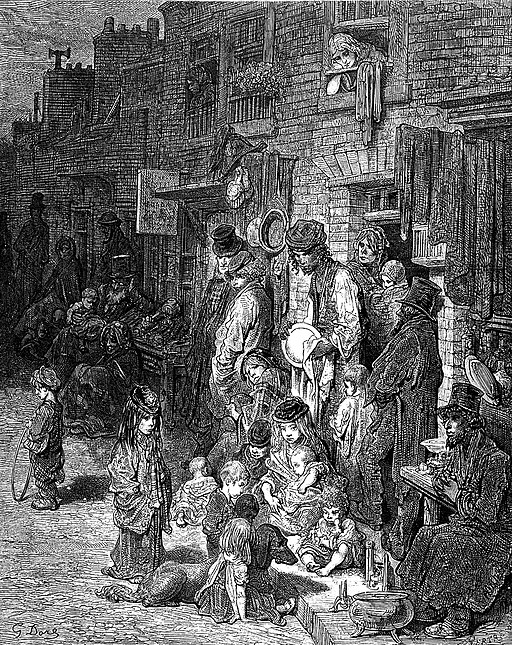
Wentworth st, Whitechapel, 19th Century Gustave Doré / CC BY. Photo by Wellcome Images from Wikimedia Commons.
With the effects of repeated capitalization and housing inflation, the crisis had also extended to civil servants, white-collar workers and craftsmen. Threatened as it now with impoverishment and proletarianization, the petty bourgeoisie stood at the heart of early housing reform.
As the group that was key to maintaining the social order, it emphasized its social importance. According to writers of the period, social decline could result in moral degeneracy, the disintegration of the family, possible solidarity with an emerging social democracy and, above all, the possibility of overt class antagonisms.
The fact that a discursive reversal was occurring and that the housing question was not the cause but rather the consequence of contemporary social conditions was the core of Friedrich Engels’s polemic The Housing Question, which viewed every reform as resulting in a dead end. The housing issue did receive attention and remedy in a form that soon became representative of the standard treatment of the social question in public discourse. Indeed, it provided the opportunity to open up a field for regulatory interventions through social provision, education and reform, but without addressing the actual causes, namely social inequality or exploitation.
To avoid discussing real housing miseries as an obvious product of broader social ills, they were often omitted from reform discourses. Instead, reformers went into a detailed treatment of matters pertinent to the housing question, but always remained at a safe distance from the issue of material misery. The fear of contagion and plague, for example, made air quality a much-studied subject of housing reform.
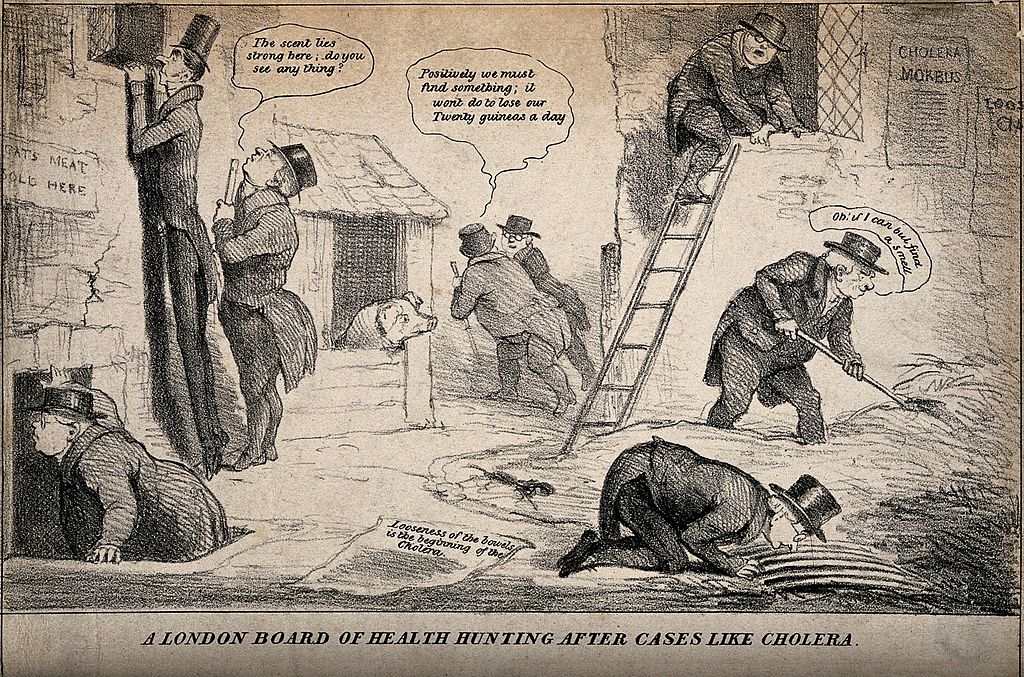
London Board of Health searching the city for cholera during the 1832 epidemic. Lithograph, 1832. Photo by Wellcome Images from Wikimedia Commons
A range of techniques related to the ventilation of rooms or for venting, filtering, and, if necessary, combusting contaminated air in furnaces (and even the design of yards or buildings) required expertise not only from the fields of medicine and hygiene, but also from disciplines such as statistics, planning and engineering (as exemplified in D’Avigdor 1874). The theory of miasmas, according to which disease is carried by dark, heavy, contaminated air from cellars and sinister holes into people’s dwellings, persisted until the end of the nineteenth century (and was to live on in the great importance attached to air by architects in the twentieth century). This belief was accompanied by the idea that ill health and contagion might stem from poverty. However, class distinctions were overlooked, suggesting the bourgeoisie’s fear of proximity to poverty and urban density.
Land ownership and surplus value
Land was also paid special attention. A combination of commercial and labour reforms, changes in production and the gradual separation of work from housing meant that land and housing had slowly become tradable commodities. From the moralistic perspective of conservative reformers, income from land ownership was always unearned, as it did not result from honest toil. (The fact that other kinds of commercial profit are by no means the fruit of the beneficiaries’ labour and that socially produced surplus value is also appropriated through means other than rent was passed over in silence.) Criticism of this risk-free, undeserved increase in value independent of the owner’s labour had developed in the German-speaking world, especially through the work of Alfred Damaschke and Michael Flürschleim.
Attacks on the ‘Moloch of land ownership’, and on the parasitic ‘idle land usurer’, following the line of argument of the American economist Henry George, author of Progress and Poverty, all laid the foundations for land reform. George argued that social grievances were only secondary consequences of the main evil, private land rent. He argued for the abolition of private property in land. Alternatively, he proposed that, at the very least, land should be heavily taxed and that unearned increases in value (or the ‘unearned increment’) should go to the state. It was a proposal dating back to James Mill and one that his son John Stuart Mill subsequently promoted as the founder of the ‘Land Tenure Reform Association’.
This proposal, which argued that the state should intervene in the mechanisms of land and housing capital in the interests of productive (industrial) capital and draw off value gains from the former, was a powerful one. Even where no taxes on value gains were introduced, it sometimes found its way into everyday political life through housing policy. The passage of the Tenants Protection Act, for example, led to a freeze on rents during the first Austrian Republic and resulted in a de facto devaluation of land capital in favour of productive capital, which made it possible to keep wage levels down (an important measure in the post-1945 period).
However, considerations of how reforms might actually be implemented went beyond the political economy of the land to the idea of actively addressing the housing shortage by building. In the German-speaking world, financial measures date back to the beginnings of public debate around the housing issue. Just months after the Silesian weavers’ uprisings of 1844, which created an awareness that the material hardship of the working population could translate into a threat to the social order, money was allocated by the state for premium savings funds for building housing. But the funds went to industry, saddling workers with a double dependence. The publicist and housing reformer Julius Faucher proposed to merge construction companies and savings banks into building associations, which were to provide apartments managed by ‘provident hands’.

The March of the Weavers in Berlin. Photo by Käthe Kollwitz – Wikiart from Wikimedia Commons.
Around the same time, Victor Aime Huber deployed the concept of self-help, introducing the notion of linking the cooperative model with the construction of cottages, including community facilities for families and Christian education. The aim was for workers to purchase their homes gradually through the rent they paid, to overcome their ‘lack of order, economy and cleanliness’ and to integrate into the community with an ‘orderly family life’. From the outset, the project of creating and financing sufficient housing went hand in hand with exhortations to frugality, domesticity, morally upstanding living and model family life.
Housing and discipline
In continental Europe, ideas and efforts from France in large part inspired the reform projects that saw education through and for housing as a major contribution towards securing social peace. There, a school of thought was being developed by a circle around Frederic Le Play and a number of Saint-Simonists about using conservative social reforms rather than police action to restore a social order that had disappeared.
Inspired by model houses at the World’s Fair in London in 1848, Louis Napoleon had sent a delegation to research English workers’ houses and had workers’ houses built, hoping to simultaneously provide living space and secure social control over the city of Paris. He also had Henry Roberts’s The Dwellings of the Labouring Classes translated into French.
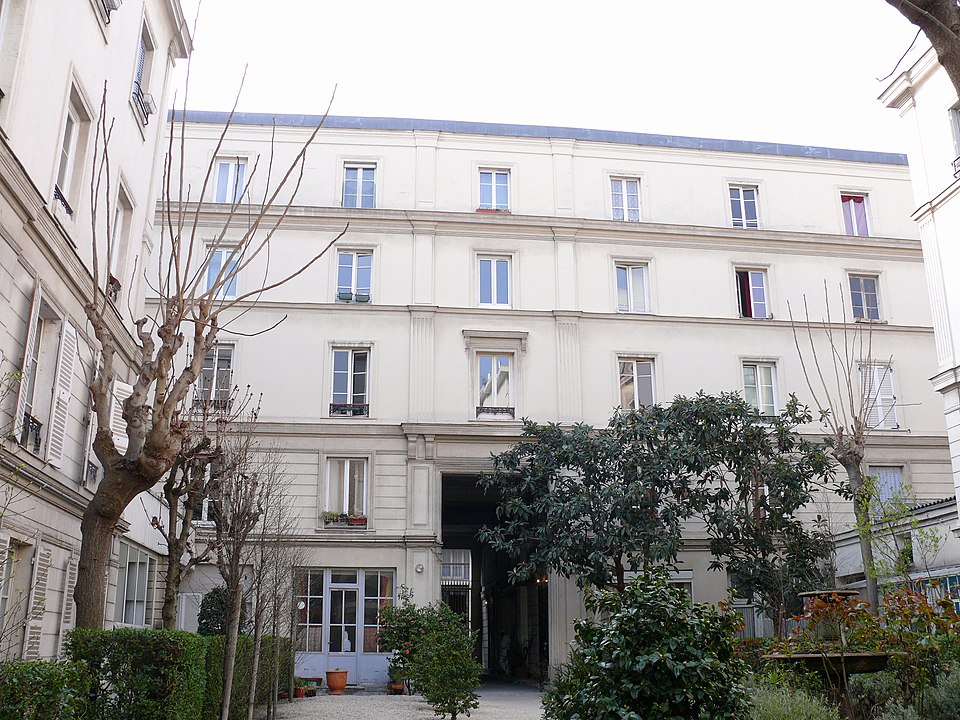
Cité Napoléon Photo by MOSSOT from Wikimedia Commons
The Cité Napoleon of 1851 was one of the first blocks of flats for workers. Planned for 500 people, it was an early state housing project, with facilities such as laundries, bathrooms and communal spaces. The house rules included over 100 points, governing matters in the building from curfews to how best to raise children. Despite the housing shortage, however, workers saw it as a paternalistic disciplinary machine and boycotted it. Plans for further Cités were abandoned, but the idea spread throughout Europe and was imitated in a modified form in several cities.
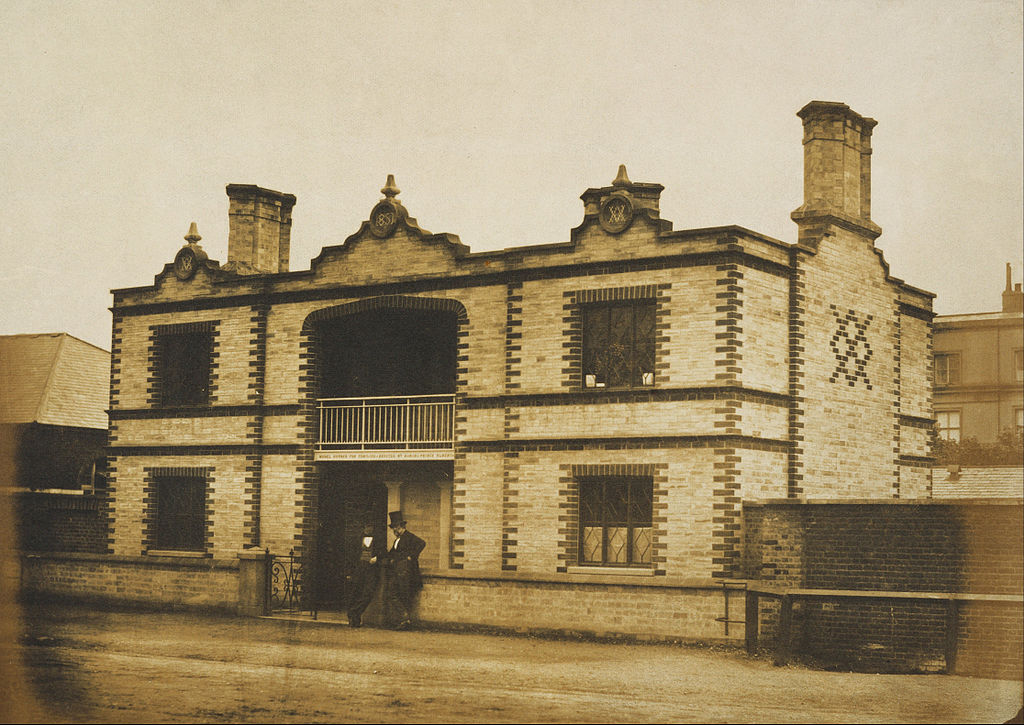
The Great Exhibition, 1851: Model House for Families designed by HRH Prince Albert Photo by Claude-Marie Ferrier via Royal Collection from Wikimedia Commons.
This early social housing was supported not so much by the labour movement itself, but by philanthropic societies, bourgeois reform parties, Christian workers’ associations, and social liberalism. Only later, when the social democratic movement grew and won state power, were effective tools sought for improving the living conditions of the population. The ideas of conservative social reform were reformulated and adapted to the progressive programme of social democracy, eventually finding their way into large-scale housing programmes.
Minimal housing and subsistence
The housing question, housing reforms, and, in particular, cities’ awarding of construction contracts, all compelled the disciplines of architecture and planning to re-orient themselves towards the masses. This realignment meant a shift away from building tradition and historical reference and towards economic efficiency and rationality as well as planning and science.
The enthusiasm, contradictions and pitfalls in this project are nowhere more evident than in the proceedings of the 2nd International Congress of Modern Architecture (CIAM), which took place in Frankfurt in 1929. With the topic ‘The problem of constructing affordable housing for the lowest-earning sections of the population’ as their focus, a group of architects began to examine planning for the dispossessed and, more generally, for a new society. In light of the gap between incomes and costs in the production of housing, the group took the view that state intervention was essential for achieving good, healthy housing. But they wanted to make use of technology, industry and reason in order to find cheap and efficient solutions.
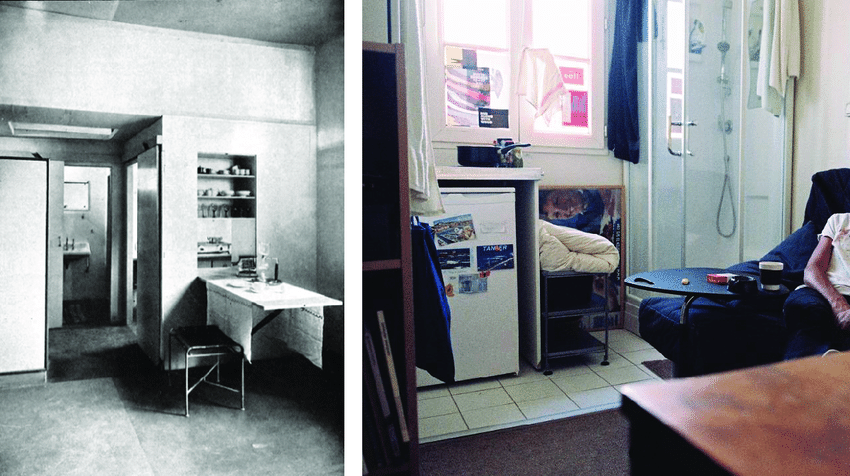
Minimum dwellings from II CIAM to today. From left to right: View of a bachelor room (Junggesellenzimmer), architect Kienzle (Giedion, 1929); Parisian micro-flat (Ghislain, student, in his fifth floor 10m 2 apartment; Macherez, 2015). Source publication
As part of the project to build an enlightened, democratic society of the future, they found themselves in the paradoxical situation of wanting to conform to the logic of industry and the market as well as to that of the dispossessed. This avant-garde group chose the path of the ‘built minimum’, with basic needs set out in numbers, tables and diagrams in order to establish a minimum basis for housing. ‘The problem of the minimum dwelling’, as Walter Gropius put it (and therefore also the problem of design and architecture), ‘is that of establishing the elementary minimum of space, air, light and heat required by man in order that he be able to fully develop his life functions without experiencing restrictions due to his dwelling’.
According to this view, however, the dwelling remains little more than an instrument for the reproduction of labour power. The desire to build for a new society gave way to a pragmatic interest in ensuring social peace. In the face of sanitary emergency and the threat of social unrest, the proposed remedy was the minimal dwelling and architecture accepted this challenge. A competition commenced in which architects tried to outdo one another in the optimization of living space, until the bare minimum was achieved as Giancarlo De Carlo later noted. Given the housing situation in Europe’s cities, the time had come for the avant-garde pragmatism of New Objectivity and architecture delivered.
But in the absence of additional financial support, such as the regulation of land prices and state subsidy through progressive taxation, even minimal dwellings could not solve the housing question, let alone the social question; flats were still too expensive. Moreover, the dictate of minimum and optimization would endure well into the post-1945 era of functionalism, with its economic growth and the welfare state. Its continued life was of great benefit to the construction industry, but a misfortune to the tenants it affected.
The reality of this form of modernity was one of the boredom, monotony and shortcomings that we discussed at the start, all of which would eventually be the subject of decades-long criticism. But what should not be forgotten among the criticism is that this particular modernist project had a different starting point. It was a project aiming to stretch architecture and planning only as far as was strictly needed. Its aim was not to create an architecture in the service of everyone.
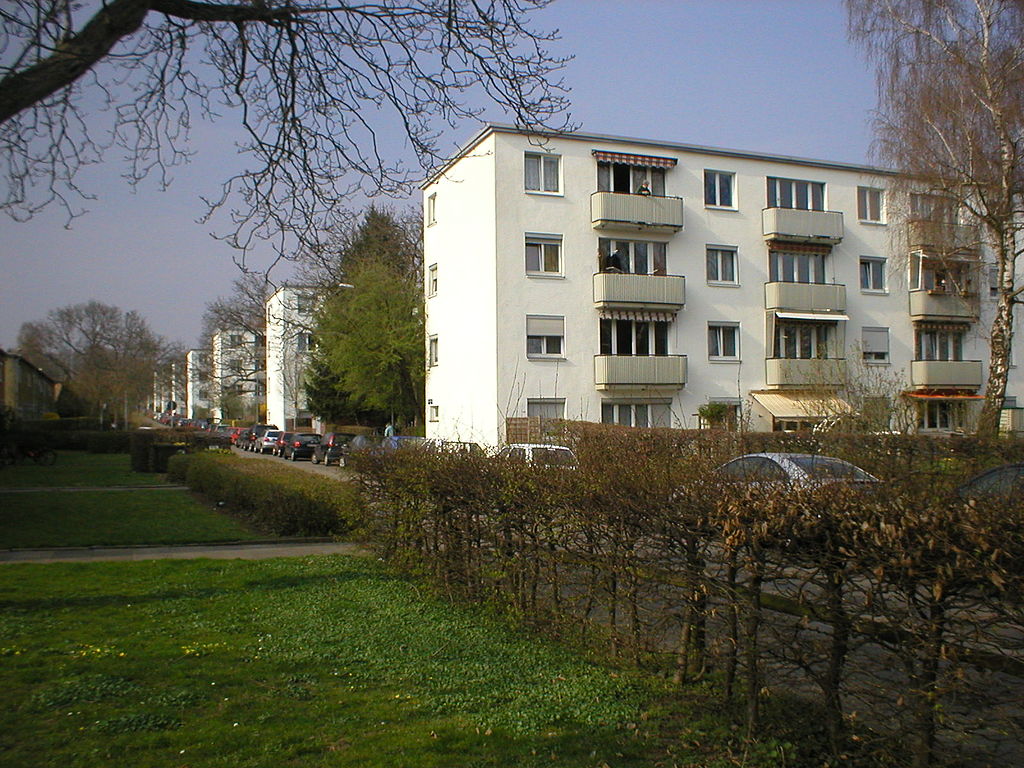
Siedlung Westhausen (1929-1931) was involved in the development of the Neues Frankfurt project. Architects: Eugen Kaufmann, Ernst May, Ferdinand Kramer, Franz Schuster and Andere. Photo by Christos Vittoratos from Wikimedia Commons
An updated housing reform
The parallels between today’s debates about housing and their historical antecedents do not lie so much in the direct repetition of past crises. The standard of housing for many people today is far removed from the realities of nineteenth-century dwellings, thanks in part to a series of reforms and struggles that introduced rent controls, tenant protections, social housing and other measures. The mechanisms of housing distribution are not the same today as they were in the nineteenth century, and the logic of their exploitation by capital has also changed. Rather, the parallels can be seen in the patterns that underlie the discourse, in the lines of argument deployed, in the role attributed to the housing question and in the remedies suggested.
Perhaps the most important parallels are to be found in the updating of the land reform debate. Revived in recent years, there is an ongoing discussion about taxation on and income from urban land, of value gains and zoning profits. It has been most heated where land reserves are scarce and where increased demand has sent housing prices skyrocketing. Three actors were and remain opposed here: landowners, productive capital and people. While the first two aim to maximize their profits, and are thus in competition, the third has an interest in affordable housing. Moreover, the public sector, currently the largest owner of land, provides the infrastructure, establishes the general conditions for productive activity and must mediate between the other two interests.
Housing markets do not follow the law of supply and demand, as more affordable housing is not created where the demand for cheap housing is high; this has been demonstrated time and time again with the growth of cities and the development of housing markets. Where it has to cover the financing of the land, affordable rent is reliant on low basic costs and the profits of productive capital.
Regulating income from commerce in land is therefore one obvious measure, but the proposal to tax land value gains is also pragmatic. It is relatively easy to implement and at the same time easier to argue than the taxation of income from companies that have to finance work and production. One cannot completely hide the ensuing undertones of moral judgement of undeserved added value and honest work, which permeated the discourse around land reform in the nineteenth century.
While the discussion about land still largely follows the lines of the earlier argument around land reform, the considerations that bear upon building affordable housing have changed significantly. Social housing models and strategies have long since dropped the educational tenor of earlier housing reformers. The disciplinary gestures of previous projects have given way to sober provision, and the cooperative system is now a mere organisational form. It has long ceased to be a means of educating through thrift. Paradoxically, remnants of the moralism of co-operative reform can be found today in attempts to develop alternatives to established forms of housing through new cooperatives, or through the efforts of a community that is often enough exclusive in the end. However, then as now, organized self-help was always something that emerged from and served the middle classes.
The change in housing reform began with the major construction programmes of the interwar period and the era of the welfare state that saw the rise of the idea of housing provision as a social right (in Marshall’s sense in 1950) to which one could make a claim. Housing was no longer regarded as a matter for philanthropic compassion or Christian charity, until the re-commodification of housing began in earnest. Even today, the state housing agency is thought of as an example of the nanny state in action. But in light of the increasing tendency of the rental market to charge ever-higher rents for housing on ever-more precarious terms, criticism of social housing’s disciplinary side are gradually becoming more muted.
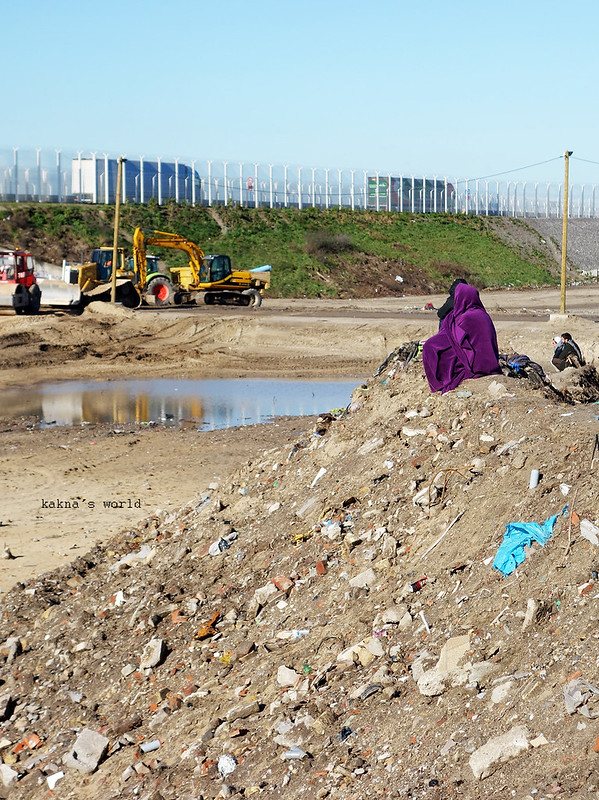
13 days before the eviction and dismantling of the Calais ‘Jungle’, France. Photo by kakna’s world from Wikimedia Commons.
The housing issue and the middle class
Once again, the housing questions gained wide attention when it reached the middle class. Facing rising rents, middle-income groups fear being unable to afford their own flat. When combined with the loss of other previous privileges, the cry for reform is being raised. But many contributions to the debate have long ignored the realities of those who were the first to experience rising rents, particularly those without money, recent arrivals such as refugees or undocumented immigrants, or those who slipped through the social welfare system.
The unpleasant images of poverty were long overlooked. It didn’t seem important to confront them. Now that the housing crisis is threatening a well-established majority, the ‘frightful images’ are receiving their due. When it was simply too hard to face reality, to develop strategies that could counter this grinding poverty, arguments about hygiene and safety won the day. The eviction of a refugee camp in Calais in March 2016 that provided temporary shelter for about 4,000 people; the forcible removal of a 400-person Roma camp in Paris in January of the same year; and the eviction of a number of other settlements over several years prior – all of these acts were justified by appeals to the sanitary and hygienic threats posed by the camps. Only a mere fraction (29) of the 11,538 people affected by forced evictions in France last year were offered alternative accommodation.
Even if none of the camps were directly connected with regular housing stock, they cannot be separated from the mechanisms and reality of access to and distribution of housing, from housing policy and from the housing question. On the contrary, now as before, the housing question is a part of the social question. The question is how we live together in our cities, which cannot be separated from everything else. It is merely one part of the social question.
Society’s contradictions cannot be solved through housing policy alone. But housing highlights some of the contradictions that we have to confront. For that reason, we cannot give up on the housing question.










